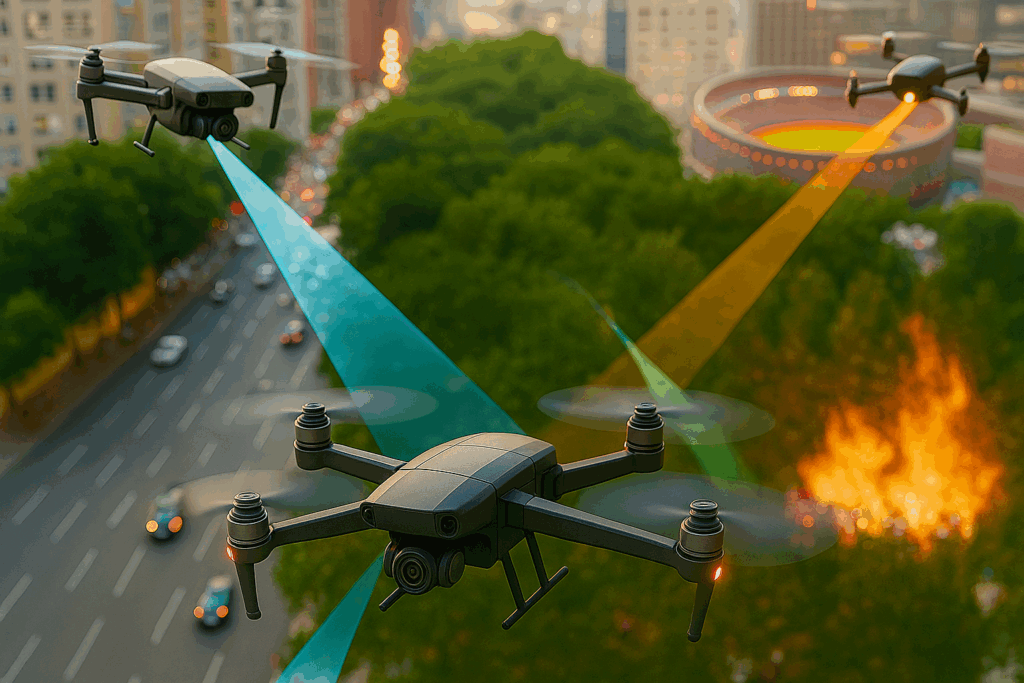AI in live streaming is rapidly transforming how organizations monitor, analyze, and respond to events in real time. As artificial intelligence continues to evolve, its integration with video surveillance systems enables faster, smarter, and more efficient decision-making across industries from public safety and smart cities to industrial operations. In this blog, you will learn how… Continue reading How AI-Based Video Analytics Enhances Video Surveillance
AI in live streaming is rapidly transforming how organizations monitor, analyze, and respond to events in real time. As artificial intelligence continues to evolve, its integration with video surveillance systems enables faster, smarter, and more efficient decision-making across industries from public safety and smart cities to industrial operations. In this blog, you will learn how AI is reshaping the video surveillance market, what use cases and trends are driving adoption in 2025, and how technologies like Red5 Pro’s XDN platform enable real-time, AI-powered streaming at scale.
Our co-founder and CEO, Chris Allen, talked about ‘AI and the Next Wave of Real-Time Video Intelligence’ at the RTC.On conference in Poland. If you’re interested in the latest innovation in this space, watch this recording on Youtube:
Table of Contents
AI Trends in Video Surveillance Market
AI adoption in video surveillance is accelerating as organizations seek faster, more accurate, and automated ways to detect and respond to real-time events. Analysts project exponential growth driven by advances in computer vision, edge AI, and cloud-based video analytics. According to Research and Market, the AI in video surveillance market is forecasted to grow by USD 10.89 billion during 2024-2029, accelerating at a CAGR of 22.7% during the forecast period.
Here are key trends shaping AI in video surveillance space for 2025:
- Shift from Analog to IP-Based Systems: Traditional CCTV systems are being replaced by IP-based digital cameras that support high-resolution streaming, digital zoom, and frame-rate adjustments. This transition enables seamless AI computer vision integration for smarter, automated analysis.
- Edge AI for Real-Time Decision Making: AI algorithms are increasingly deployed at the edge (directly on cameras and gateways) to reduce latency and bandwidth costs. This allows faster object detection, event recognition, and response without relying solely on cloud servers.
- Cloud-Based Analytics and Scalability: Many modern systems now process video feeds in the cloud, making it easier to store, analyze, and share large volumes of footage. Cloud scalability also supports AI model updates and continuous performance improvements across multiple sites.
- Behavioral and Anomaly Detection: AI-powered models are now capable of recognizing behavioral patterns, predicting threats, and identifying anomalies in both video and audio. These advancements are being applied in sectors such as transportation, retail, and critical infrastructure.
- Integration of Multimodal AI Models: Combining video, audio, and sensor data provides deeper situational awareness. Multimodal analysis improves event classification and accuracy, especially in complex environments such as airports, ports, and urban surveillance grids.
- Privacy-Aware AI and Regulatory Compliance: The rise of AI-driven surveillance has accelerated discussions about privacy and ethics. Vendors are introducing on-device data anonymization, facial blurring, and GDPR-compliant data handling mechanisms to address growing regulatory requirements.
- Adoption Across Diverse Environments: Surveillance is expanding beyond static camera networks to include drones, body cameras, mobile phones, and IoT devices. These multi-environment deployments improve visibility in hard-to-reach areas such as tunnels, warehouses, or remote border zones.
- Rise of Predictive Analytics and Preventive Monitoring: AI is evolving from reactive alerting to proactive prediction identifying risks before they escalate. Predictive maintenance, theft prevention, and accident forecasting are becoming key differentiators for surveillance technology providers.
- Growth of AI-Powered Smart Cities: Governments and municipalities are investing heavily in AI-driven surveillance to manage traffic and smart cities, public safety, and environmental monitoring.
How AI Can Be Utilized in Video Surveillance

AI monitors video surveillance feed
AI is already widely used in areas like content generation, predictive analytics, and workflow automation. But it can also be applied to live streaming and video surveillance, where it mimics human-like perception and reasoning to enhance system performance and improve real-time decision-making. In surveillance scenarios, AI agents can monitor multiple camera feeds simultaneously, catching details that would otherwise go unnoticed by human operators.
Here are a few scenarios where AI can enhance video surveillance operations:
- Live Video Monitoring and Security: Facility monitoring, property surveillance, and IP camera streaming for real-time detection of suspicious or unauthorized activity.
- Government and Public Safety: Drone-based monitoring, traffic management, and defense operations that rely on automated identification and situational awareness.
- Industrial and Manufacturing Facilities: Continuous monitoring of assembly lines, equipment, and restricted zones to prevent hazards and ensure compliance with safety protocols.
- Smart Cities: Traffic flow management, crowd monitoring, and early detection of environmental changes like fires, floods, or air quality issues.
- Retail and Commercial Spaces: Monitoring customer behavior, detecting theft, and analyzing occupancy trends to optimize store layouts and staffing.
- Healthcare and Hospital Environments: Identifying whether personnel and visitors are following safety measures, such as wearing masks or protective gear.
- Transportation and Logistics: Tracking vehicles and cargo in ports, airports, or highways to identify bottlenecks and enhance operational visibility.
- Agriculture and Wildlife Management: Monitoring livestock or tracking animals across large areas for research, conservation, and safety purposes.
How AI-Based Video Analytics Enhances Video Surveillance

Different situations where video surveillance with drones can be useful.
AI-based video analytics enhances surveillance by enabling systems to process and interpret live feeds in real time, providing actionable insights that support faster and more informed responses. These capabilities can be grouped into key areas:
Object and Activity Recognition
- Detects specific objects such as people, vehicles, and equipment.
- Identifies trespassing, unattended baggage, or restricted-area entry.
- Recognizes compliance-related details such as hard hats or safety vests.
Event and Anomaly Detection
- Flags irregular behaviors, motion patterns, or unauthorized access.
- Detects crowd formation, vehicle congestion, or potential accidents.
- Identifies unusual audio or visual events such as explosions, alarms, or broken glass.
Environmental and Infrastructure Monitoring
- Detects early signs of wildfires, floods, or other natural hazards.
- Monitors energy infrastructure and industrial assets to prevent breakdowns or leaks.
- Supports predictive maintenance through real-time anomaly tracking.
Image Enhancement and Data Processing
- Restores low-quality footage and stabilizes images for better visibility.
- Applies noise reduction, color correction, and motion estimation to clarify visuals.
- Generates metadata for indexing, storage, and later retrieval of critical footage.
By combining these capabilities, AI-based analytics transforms traditional surveillance into a proactive, data-driven system that can operate continuously, adapt to changing conditions, and deliver intelligence far beyond human monitoring capacity.
Real-Time AI-Powered Video Surveillance Technology
The most effective surveillance solutions use real-time latency to synchronize video and data elements in time with events as they occur in reality. This high degree of responsiveness is only possible with the recent development of experience delivery network (XDN) technology. Prior to an XDN, most video streaming was done with a content delivery network (CDN). CDNs lean heavily on HTTP protocols such as HLS and MPEG DASH which depend upon caching data to facilitate the delivery of streaming video. Caching is counterproductive to ultra-low latency streaming and will always produce at least a second of latency which is nowhere near close enough to the sub-250-milliseconds benchmark for real-time latency.
This new approach to video surveillance is unfolding in a growing number of scenarios where smart-city operations, emergency responders, businesses, and military are relying on Red5 Pro’s multicloud XDN platform to enable comprehensive real-time insight into live events. These surveillance system operators are able to coordinate scrutiny and analysis of one or more occurrences to whatever extent of geographic coverage is necessary.
No matter how many cameras are involved and where they are deployed, their output is fed to XDN origin nodes for simultaneous real-time distribution to all points involved in the formulation of event responses, including cloud-based analytics engines as well as manned posts. Surveillance managers are assured the scalability, redundancy, and content protection they need to ensure their operations are adequate to the tasks at hand.
Conclusion
AI-powered video surveillance is moving beyond simple motion detection toward intelligent, automated systems that can analyze, interpret, and act on live data instantly. With the combination of AI-based analytics and ultra-low latency streaming made possible by Red5 Pro’s XDN technology, organizations gain continuous visibility and faster situational awareness in critical scenarios, from smart city operations to emergency response. As adoption grows, these innovations are redefining how we secure, monitor, and understand the world in real time. Also check out our white paper on surveillance.
Try Red5 For Free
🔥 Looking for a fully managed, globally distributed streaming PaaS solution? Sign up for Red5 Cloud today! No credit card required. Free 50 GB of streaming each month.
Looking for a server software designed for ultra-low latency streaming at scale? Start Red5 Pro 30-day trial today!
Not sure what solution would solve your streaming challenges best? Reach out to our team to discuss your case.
The Red5 Team brings together software, DevOps, and quality assurance engineers, project managers, support experts, sales managers, and marketers with deep experience in live video, audio, and data streaming. Since 2005, the team has built solutions used by startups, global enterprises, and developers worldwide to power interactive real-time experiences. Beyond core streaming technology, the Red5 Team shares insights on industry trends, best practices, and product updates to help organizations innovate and scale with confidence.

